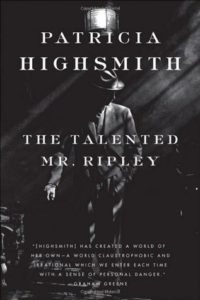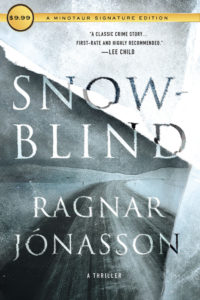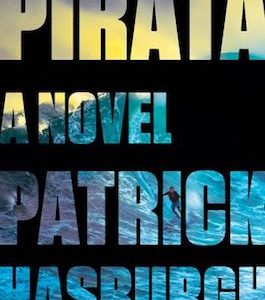The poet W.H. Auden once wrote, in an essay about detective fiction: “Nature should reflect its human inhabitants. . .the more Eden-like it is, the greater the contradiction of murder.” Sometimes, then, a sweet and transcendent setting will throw a novel’s vile or venal acts into stark relief, making them even more shocking. Of course, the opposite can be true too: the frightening majesty of nature—its violent otherness, its immense power—can intensify the horror of a cruel or brutal deed. I think about settings a lot in my own writing, and they are a huge part of the suspense in my novels. In my debut, The Missing One, a young mother goes to the Pacific Northwest with her toddler son in search of her mother’s secret past (as an orca researcher). I used the landscape to ramp up tension and fear in this novel, deliberately sending my poor character to an isolated and exposed island in a remote archipelago, where crashing storms sweep in from nowhere, and fog can engulf everything. In my latest novel, The Night Visitor, I used two contrasting settings: a Gothic manor house in the English countryside, ominous and slightly dilapidated, and a glorious vacation home in the South of France. A shocking and violent act takes place in both, and the settings contribute massively to that. I was, of course, only following a long and illustrious line of authors who use settings with transportive results. Here is a list of brilliant examples:

Italy in Patricia Highsmith’s The Talented Mr. Ripley
The Italian landscapes of Highsmith’s 1955 psychological thriller range from Dickie’s hideaway in the elegant, rustic fictional town of ”Mongibello,” to the glories of Rome or the ornate charms of Venice. Against this romantic Fellini-esque Italian backdrop the bloody deeds of our disturbed outsider, Tom Ripley, feel even more deranged and chilling in this magnificently dark novel.

Wind Gap, Missouri in Gillian Flynn’s Sharp Objects
Maladjusted Chicago-based reporter Camille returns to her hometown of Wind Gap, Missouri, to report on a couple of grisly crimes. The once grand, now down-at-heel Wind Gap is the classic claustrophobic small-town American setting, all suspicious locals and beautiful, derelict buildings. Danger oozes from every corner as Flynn (the author of Gone Girl) begins to scratch the surface to reveal the twisted secrets beneath.
The Tallis home in Ian McEwan’s Atonement
The idyllic country pile of the genteel Tallis family in Ian McEwan’s novel is pre–World War II England in all its glory: the expansive green lawns, the pool, the humble servants, the tasteful antiques. The posh English country house setting of course deliberately creates the atmosphere of an Agatha Christie novel as McEwan presents his setting as the essence of well-to-do privilege. Of course the tense and disastrous interactions that unfold there, culminating in the crime itself—a false accusation of rape—bring the grand walls crashing down (metaphorically speaking). This is a masterclass in settings that speak volumes about crime, class, transgression, lies, and pretense.

The Caribbean in Jean Rhys’s Wide Sargasso Sea
Set mostly in Jamaica and Dominica shortly after the abolition of slavery, Rhys’s 1967 novel explores the back story of Antoinette, the white Creole woman who ends up mad and living in Rochester’s attic as Bertha in Charlotte Brontë’s Jane Eyre. This is, of course, really a pre-crime novel, built on suspense and darkness, the prequel to the real crime that is played out in the margins of Jane Eyre, where a man takes a woman, brands her mad, and locks her in his attic until she dies. Lush, hot, dripping with sexual menace and otherness, Rhys’s Caribbean creates an unsettling and unforgettable atmosphere of tension for this fraught exploration of race, injustice, betrayal, passion, and the crime of a stolen identity.
Iceland in Ragnar Jónasson‘s Snowblind
Iceland has a population of only 300,000, but it is apparently the most literary nation on earth. About 1 in 10 Icelandic people will publish a book in their lifetime, and a vast proportion of those, judging from the recent explosion in “Icelandic Noir,” will be dark, atmospheric, and completely gripping. Ragnar Jónasson is a perfect example. He sets Snowblind in a small northern Icelandic fishing community in the dead of winter. The weather, as you can imagine, is ferocious, with blizzards and avalanches creating a locked-in trap for our rookie cop hero to survive. There is nothing like calamitous white weather and a sinister cut-off town to generate nail-biting peril.
Small-town Texas in Attica Locke’s Bluebird, Bluebird
The tiny Texan town of Lark, population 178, is the evocative location for Attica Locke’s brilliantly tense 2017 crime novel. An impoverished backwater, Lark was once a plantation and now simmers with racial tension and contradictions. The townsfolk can be secretive and cunning, but also kind, caring, sweet; the landscape can be both beautiful, with its amazing trees and red soil, and impoverished, dry. We see the place and its inhabitants through the eyes of Texan ranger Darren Mathews, who grew up there, the nephew of the town’s first black ranger. Mathews’s love for his hometown is clear, but so is his appreciation of its more sinister undercurrents. A brilliant example of an author using her settings not just to enhance the tension of the plot, but to speak volumes about big issues—race, boundaries, home, transgressions, identity. Even Lark’s geographical location is symbolic. The town rests on U.S. Highway 59, Locke writes: “For black folks born and bred in rural communities along the highway’s north-south route, Highway 59 has always represented an arc of possibility, hope paved and pointing north.”

Multicultural Paris in Karim Miské’s Arab Jazz
This 2015 crime debut from French author Karim Miské moves seamlessly between a vibrant and multi-cultural Paris, where the main character awakes to find his upstairs neighbor’s blood dripping through the ceiling, and across the Atlantic to a complicated New York. The Paris setting, particularly, burst with sultry detail—a brilliantly complex place that reflects the novel’s tangled, interconnected, and fraught themes of racial and national identity.

The French Riviera in F. Scott Fitzgerald’s Tender is The Night
At first the Cote D’Azur in Fitzgerald’s tragic love triangle story looks like one glamorous and hedonistic 1920s party, with Dick and Nicole Diver as the hosts. Slowly we begin to witness Dick Diver’s unraveling, even as he continues the charade of drinking to excess and playing the part of the entertainer. Crimes of infidelity and undertones of sexual perversion abound. The French coast is not just glitz, it is menace (“the soft-pawed night and the ghostly wash of the Mediterranean far below”). As we begin to appreciate the psychological fragility beneath the tanned and beautiful skin, it feels even more poignant; the perfect, toxic cocktail that only Fitzgerald can mix.

Christminster in Thomas Hardy’s Jude the Obscure
For hopeful country boy Jude, Christminster is “the city of light” or “the new Jerusalem.” A fictionalized version of Oxford, the city is all elegant stonework, dreaming spires, and intellectual ambition. Of course, this being a very tragic Thomas Hardy novel, Jude’s dream of becoming a scholar is doomed, and Christminster becomes not just a symbol of everything that is unfair and rigid about British society, but the location for a murder and the aftermath of an unspeakable family tragedy. Oxford never looked more stunning, or more impenetrable.

The Hebridean Isle of Harris in Peter May’s Coffin Road
Scottish author Peter May has set many of his novels in the Hebrides and the setting of windswept Harris for his 2016 crime novel is a perfect example of using a real place to enhance a dark fictional mood. The beautiful Hebridean landscape—a stunning wilderness of ever-changing shadows—enhances the detailed development of May’s complex, multi-layered plot. In the opening pages of Coffin Road a man is washed up on the beautiful beach at Luskentyre with no memory of how he got there. From then on, May anchors his story tightly to this ancient, mystical Hebridean landscape, and to the small island community, creating a vivid, timeless sense of danger. Tourist offices in the Hebrides now talk of the “Peter May effect” for good reason: May brings Harris fully to life in all its forbidding and magnificent glory here. You’ll remember the feel of the place long after you have forgotten the ins and outs of the intricate plot.




















